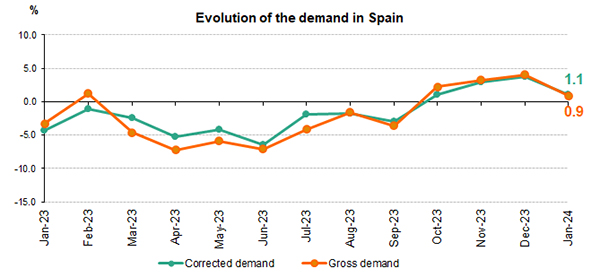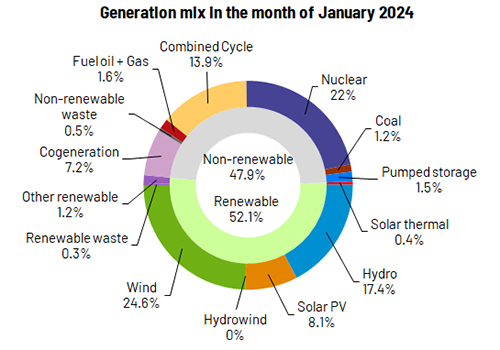For 40 years, we've been driving our country's economic and social progress. Four decades shaping Spain.
Demand for electricity in Spain grew 1.1% in January
- 52.1% of electricity production during the month came from renewable sources, totalling 12,202 GWh. Wind power was the leading source of generation in Spain for the fourth consecutive month and accounted for 24.6% of the month's total electricity production
- Noteworthy is that 75.3% of electricity production during the month was obtained using zero-carbon energy technologies
National electricity demand in January experienced a 1.1% increase year-on-year after having factored in the influence of seasonal and working patterns. In gross terms, demand is estimated at 22,185 GWh, up 0.9% on January 2023.

During January, 52.1% of the electricity produced in Spain was obtained using renewable sources, registering a value of 12,202 GWh. For the fourth consecutive month, wind power was the leading source of production in the Spanish generation mix, accounting for 24.6% of total electricity production (5,755 GWh).
Hydro, boosted by the favourable rainfall registered in part of the mainland, ranked third in the national generation mix, with 17.4% of the total and a production of 4,084 GWh, up 5.8% on the values registered in January 2023. In gross terms, demand is estimated at 22,185 GWh, up 0.9% on January 2023.
In addition, 75.3% of January's electricity production was obtained using zero-carbon energy technologies.

Demand for electricity in the mainland system increased by 0.9%
Regarding the mainland electricity system, and after having factored in the influence of seasonal and working patterns, demand for electrical energy in January was 0.9% higher year-on-year. In gross terms, demand totalled 20,946 GWh, up 0.8% year-on-year.
According to provisional data available at the time of this press release, renewables on the mainland generated almost 54.2% of the total in January, recording a production of 12,089 GWh. Furthermore, 78.6% of the month's electricity production was obtained using zero-carbon energy technologies.
The mainland generation mix in January was also led by wind power, responsible for 25.6% of the total with a production of 5,701 GWh during the month.
Electricity demand in the Balearic Islands and the Canary Islands
Electricity demand in the Balearic Islands in January was up 4.3% after having factored in the influence of seasonal and working patterns Thus, gross monthly demand is estimated at 448,532 MWh, down 0.5% year-on-year.
In terms of generation, combined cycle, with 77.4% of the energy produced in the Balearic Islands, was the leading energy source in the islands in January. For its part, renewable energy obtained using zero-carbon energy technologies in the Balearic Islands increased by 25.2% compared to the same month last year and represented 10.1% of the total.
In addition, during January, the subsea link between the mainland and Majorca contributed to covering 27.4% of the electricity demand in the Balearic Islands.
For its part, and after having factored in the influence of seasonal and working patterns, electricity demand in the Canary Islands increased 4.8% year-on-year. In gross terms, demand stood at 754,977 MWh, up 4.9%.
In terms of electricity generation in the Canary Islands, combined cycle, with 48.7% of the total, was also the leading technology in January, while renewables and generation obtained using zero-carbon energy technologies produced 10.6% of the total production.
Consult our Daily Balance Report for more information on the National, Peninsular, Balearic Islands and Canary Islands electricity systems as at the close of January.
Consult ou
Descargas












